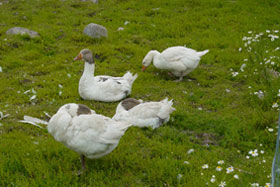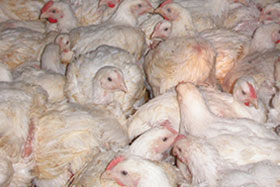Factors which affect how animals behave at slaughterhouses
Illustration not available at the moment!
Figure no. 1 Illustration of general factors which affect poultry from birth to slaughter. Figure: Viveca Sandström, SLU.
Figure no. 1 above illustrates the stages and factors which affect animals throughout their lives and up to slaughter. Boxes 5-9 take place at the slaughterhouse and can be influenced by how the environment is designed and how the animals are handled. It is important to bear in mind the background of the animals when handling them at the time of slaughter, as this may lead to greater understanding which is a positive factor in terms of animal welfare.
For instance, during its five or so weeks of life a broiler has grown from around 40 g to almost 2 kilos, which places a great strain on the bones and heart, for example. Laying hens reach ages of around 75 weeks and lay almost one egg a day, and at the time of slaughter they are physically affected by this intensive production rate. Animals from free range systems often have stronger skeletons, which protects them from broken bones when handled.
Geese often spend time outdoors and so are more used to both humans and the environment. Birds that have had more contact with the stockman during rearing are normally calmer and easier to handle. Depending on species, form of rearing, age and experience, animals come from a wide range of circumstances and so are capable of handling events on the day of slaughter to different degrees.


Different rearing systems means that animals are capable of handling events on the day of slaughter to different degrees.
Photograph: Anne Larsen, SLU (left), Lotta Berg, SLU (right).
During gathering and transport and at the slaughterhouse, birds are faced with new environments and everything that involves in respect of temperature fluctuations, smells, noises and sights, being moved and encountering other animals. Most poultry are handled in transport containers the whole way along, until they are tipped onto a conveyor belt or shackled and stunned.
Birds at intensive rearing facilities may never have experienced the cold, wind, long-term absence of feed, strong light and manual handling, for example. Geese and turkeys are often driven in groups on floors, which may present a challenge to animals that may have spent their whole lives in a single stall or never encountered unfamiliar people.
It is reasonable to assume that older animals and animals that have led an eventful life (compare for example, broilers with geese left to graze) have more chance of coping with new situations. But with experience comes wisdom, which may make the birds dubious of unfamiliar situations.
Despite the efforts of many stakeholders to make the day of slaughter as gentle as possible, e.g. by means of automated gathering, climate regulation during transport and lairage, training staff and improving slaughterhouse fittings, the environment of the slaughterhouse and the transport there can nevertheless be very stressful for the animals.
Not working at the moment!
What general factors form the basis for how the animals behave and perceive the situation up until slaughter?
Copyright © disa.se | 2024